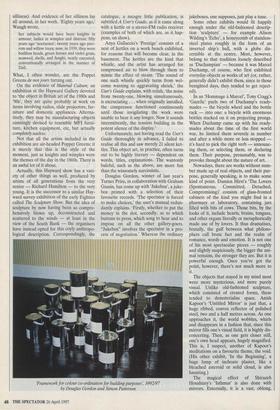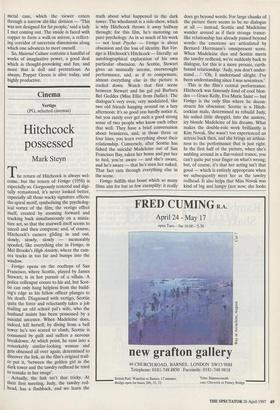Exhibitions
Material Culture (Hayward Gallery, till 18 May)
Poppet Green is alive and well
Martin Gayford
Athe start of Evelyn Waugh's Put Out More Flags, Basil Seal awakens in the stu- dio of an artist named Poppet Green. She was a girl whose outstanding silliness had immediately commanded Seal's attention (he was, you may remember, a sucker for silliness). And evidence of her silliness lay all around, in her work. 'Eighty years ago,' Waugh wrote,
her subjects would have been knights in armour; ladies in wimples and distress; fifty years ago `nocturnes'; twenty years ago pier- rots and willow trees; now, in 1939, they were bodiless heads, green horses and violet grass, seaweed, shells, and funghi, neatly executed, conventionally arranged in the manner of Dali.
What, I often wonder, are the Poppet Greens de nos fours turning out.
On the evidence of Material Culture, an exhibition at the Hayward Gallery devoted to 'the object in British art of the 1980s and '90s', they are quite probably at work on items involving radios, slide projectors, fur- niture and domestic appliances. Alterna- tively, they may be manufacturing objects cunningly devised to resemble MFI furni- ture, kitchen equipment, etc, but actually completely useless.
Not that all the artists included in the exhibition are air-headed Poppet Greens; it is merely that this is the style of the moment, just as knights and wimples were the themes of the day in the 1860s. There is an awful lot of it about.
Actually, this Hayward show has a vari- ety of other things as well, produced by artists of all generations from the very senior — Richard Hamilton — to the very young. It is the successor to a similar Hay- ward survey exhibition of the early Eighties called The Sculpture Show. But the idea of sculpture by now having been so compre- hensively blown up, deconstructed and scattered to the winds — at least in the view of the South Bank — the organisers have instead opted for this coyly anthropo- logical description. Correspondingly, the catalogue, a meagre little publication, is subtitled A User's Guide, as if it came along with a kettle or a stereo-FM radio receiver (examples of both of which are, as it hap- pens, on show).
Anya Gallaccio's 'Prestige' consists of a nest of kettles on a work bench exhibited, for reasons that will become clear, in the basement. The kettles are the kind that whistle, and the artist has arranged for compressed air to blow through them to mimic the effect of steam. 'The sound of one such whistle quickly turns from wel- come warning to aggravating shriek,' the User's Guide explains, with relish, 'the noise from twenty-one, blowing simultaneously, is excruciating . . . when originally installed, the compressor functioned continuously until those invigilating the work were unable to bear it any longer. Now it sounds intermittently, the tension building in the potent silence of the display.'
Unfortunately, not having read the User's Guide thoroughly in advance, I failed to realise all this and saw merely 21 silent ket- tles. This object art, in practice, often turns out to be highly literary — dependent on words, titles, explanations. The wantonly baleful, such as the above, are more fun than the winsomely narcissistic.
Douglas Gordon, winner of last year's Turner Prize, in collaboration with Graham Gussin, has come up with 'Jukebox', a juke- box primed with a selection of their favourite records. 'The spectator is forced to make choices,' the user's manual redun- dantly explains. 'Firstly, whether to put the money. in the slot, secondly, as to which buttons to press, which song to hear and to impose on all the other gallery-goers. "Jukebox" involves the spectator in a pro- cess of negotiation.' Whereas the ordinary Framework for colour co-ordination for building purposes, 1.992/97 by Douglas Gordon and Simon Patterson jukeboxes, one supposes, just play a tune.
Some other exhibits would fit happily enough under the old-fashioned descrip- tion 'sculpture' — for example Alison Wilding's 'Echo', a honeycomb of stainless- steel plates roughly in the form of an inverted ship's hull, with a globe dis- cernible at the centre. Most, however, belong to that tradition loosely described as Duchampian' — because it was Marcel Duchamp, of course, who first exhibited everyday objects as works of art (or, rather, generally didn't exhibit them, since in those benighted days, they tended to get reject- ed).
In an 'Hommage a Marcel', Tony Cragg's `Gazelle' purls two of Duchamp's ready- mades — the bicycle wheel and the bottle rack — into one: a bicycle with enormous bottles stacked on it on projecting prongs. When Duchamp came up with his ready- mades about the time of the first world war, he limited them severely in number and after a while more or less stopped it's hard to pick the right verb — announc- ing them, or selecting them, or declaring them. Their purpose, presumably, was to provoke thought about the nature of art.
Nowadays, there are works without num- ber made up of real objects, and their pur- pose, generally speaking, is to make some kind of point. Damien Hirst's 'The Lovers (Spontaneous, Committed, Detached, Compromising)' consists of glass-fronted cabinets of the kind you might find in a pharmacy or laboratory, containing jars filled with bits of cows. Those bits, by the looks of it, include hearts, brains, tongues, and other organs literally or metaphorically made use of by lovers. It thus dramatises, brutally, the gulf between what philoso- phers call brute fact and the realm of romance, words and emotion. It is not one of his most spectacular pieces — roughly and slightly suspiciously, the bigger the ani- mal remains, the stronger they are. But it is powerful enough. Once you've got the point, however, there's not much more to it.
The objects that stayed in my mind most were more mysterious, and more purely visual. Unlike old-fashioned sculpture, which consisted of created forms, these tended to dematerialise space. Anish Kapoor's 'Untitled Mirror' is just that, a huge ribbed, convex reflector of polished steel, two and a half metres across. As one approaches it, the world wobbles, whirls and disappears in a fashion that, since this mirror fills one's visual field, it is highly dis- concerting. Then, as one gets closer still, one's own head appears, hugely magnified. This is, I suspect, another of Kapoor's meditations on a favourite theme, the void. (His other exhibit, 'In the Beginning', a huge lump of inchoate plaster, like a bleached asteroid or solid cloud, is also haunting.) The magical effect of Shirazeh Houshiary's 'Isthmus' is also done with mirrors. Externally, it is a vast, oblong, metal case, which the viewer enters through a narrow slit-like division — 'This was not designed for fat people,' said a lady I met coming out. The inside is faced with copper to form a walk-in mirror, a reflect- ing corridor of uncertain dimensions along which one advances to meet oneself.
So, Material Culture contains a handful of works of imaginative power, a good deal which is thought-provoking and fun, and more that is dull and pretentious. As always, Poppet Green is alive today, and highly productive.




































































 Previous page
Previous page